Oven-baked and shaped in a cylinder, Datemaki or Japanese Sweet Rolled Omelette is a must-have Osechi Ryori dish on New Year’s Day. Similar to tamagoyaki, this sweet-savory omelette is tender and moist inside with a golden brown exterior and sunny shape.
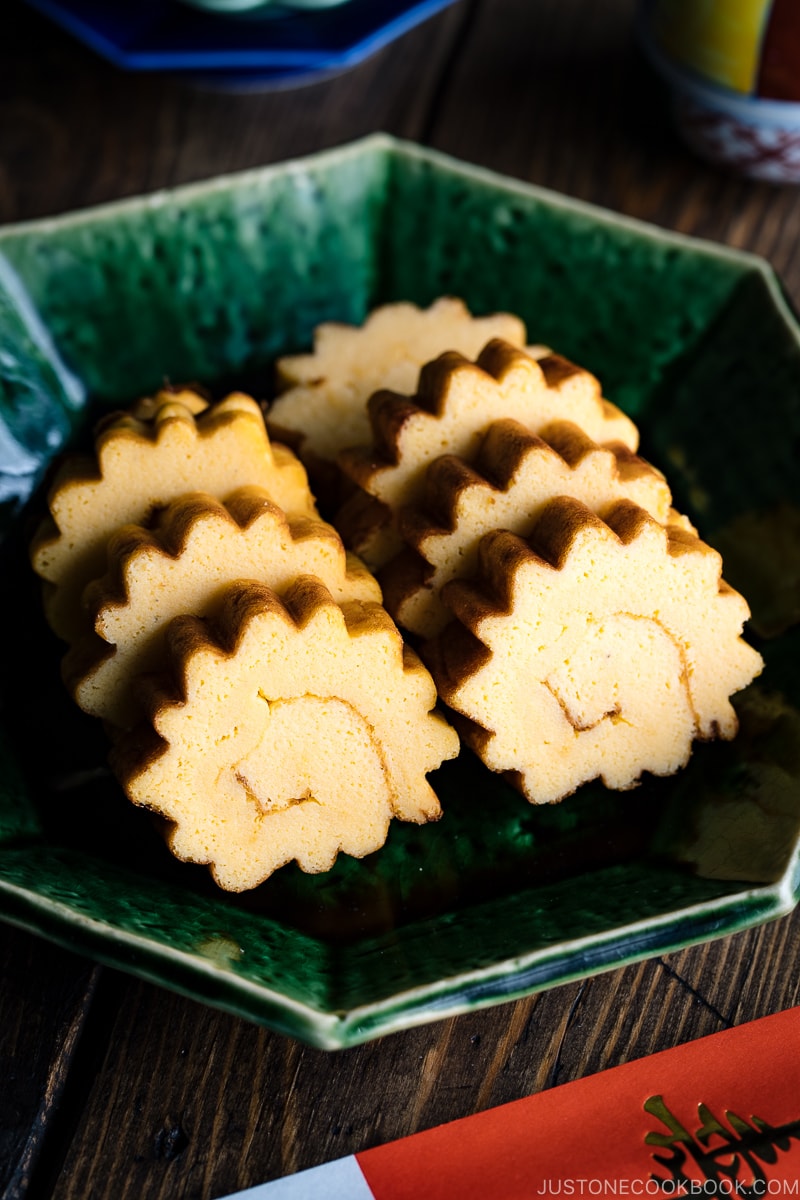
Datemaki (伊達巻) is a traditional sweet rolled omelette typically eaten as part of Japanese New Year’s food (osechi ryori, 御節料理). Served in a lacquered jubako (special square boxes similar to lunch boxes), it is made with eggs mixed with fish or shrimp paste and sweetened with sugar and mirin.
Among all the dishes for osechi ryori, datemaki often stands out for its bright sunny color and unique shape. It is by far my favorite dish among the new year foods and I always look forward to eating it every year. The sweet and savory flavor and almost cake-like texture make it a popular choice for the whole family!
You can often find pre-made datemaki being sold at Japanese grocery stores during this time of the year, but it is really easy to make it from scratch. I’ll show you how to achieve the perfect datemaki at home.
Table of Contents
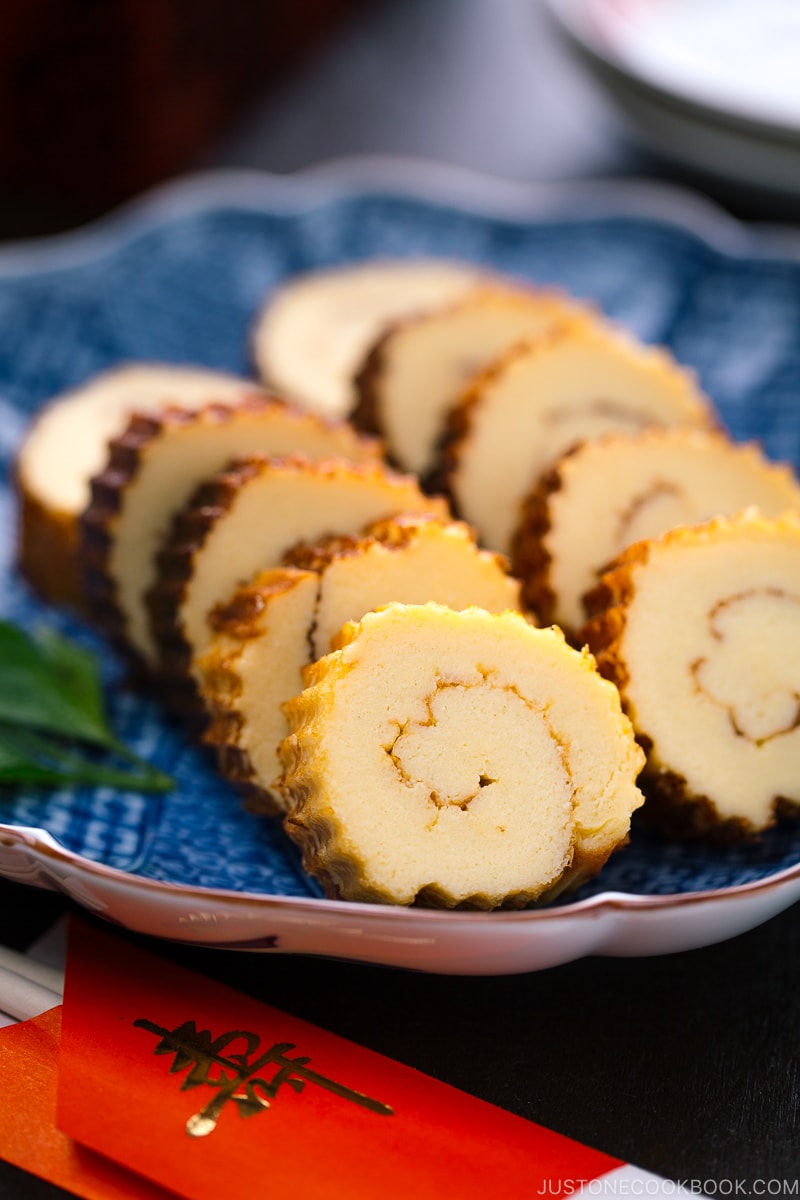
What is Datemaki
Datemaki is a must-have New Year’s food in Japan. It is similar to Tamagoyaki as both are rolled omelets with similar ingredients. The main difference is datemaki features a type of white fish cake called hanpen. Hanpen is made from grated Japanese yam (yamaimo) and surimi (Alaska Pollock), salt, and kombu dashi. It adds a unique flavor and a fluffy texture to the egg omelette, like a soft fish cake.
There are also other differences between datemaki and tamagoyaki:
- Instead of cooking on a pan over the stove, datemaki is baked in the oven in a single layer before being rolled into a cylinder and sliced. Just like baking a cake!
- Compared to tamagoyaki, datemaki is a little sweeter and is usually eaten only for the New Year.
The Symbolic Meaning of Datemaki
There are many different theories behind the symbolism of datemaki, but it is most commonly believed that eating datemaki will bring a good year of wisdom and learning, and success in studies (especially for student life). The rolled shape of datemaki is reminiscent of a scroll, which is historically a symbol of knowledge.
When I was a student, my mom would make sure that my brother and I had our good share of datemaki.
Another story was that the rolled fish cake omelet looked like a colorful kimono that fashionable people wore during the Edo period. As the word “date” refers to the sash for Japanese kimono and ‘maki’ means rolled, this is where the omelet got its name from.
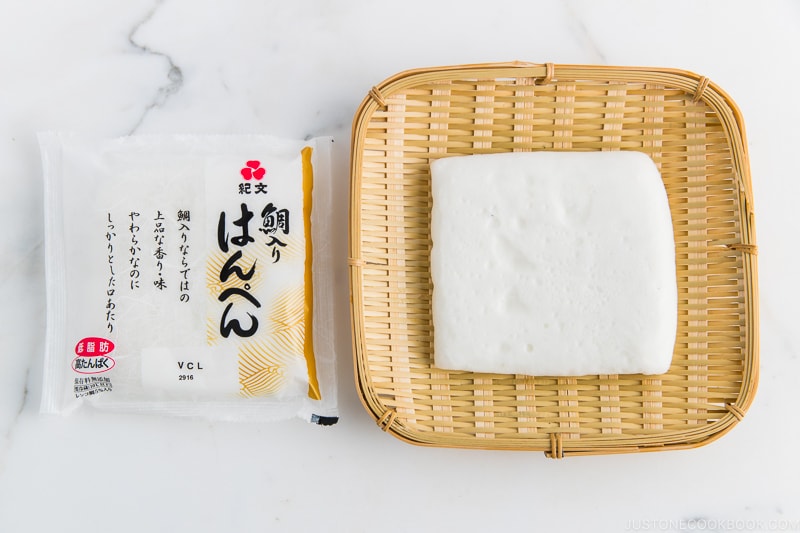
Ingredients You’ll Need to Make Datemaki
- Eggs
- Hanpen fish cake – You should be able to find hanpen in the freezer section at most Japanese grocery stores. Alternatively, you can substitute it with pureed white fish, scallops, or shrimp.
- Mirin
- Sake
- Sugar – Datemaki is meant to be sweet, but you can cut down the sugar slightly if you prefer.
- Honey
- Soy sauce
Many datemaki recipes require dashi, but I find it not necessary as hanpen is made of kombu dashi and it already adds a nice flavor to the omelette. Of course, you can always add dashi if you like.
After blending all the ingredients for the egg mixture, it is then baked until firm and nicely browned on the outside.
Helpful Tool to Roll the Omelette
You have probably seen or used makisu (巻き簀), a bamboo mat, to roll sushi or stabilize the shape of Tamagoyaki. For the decorative purposes, we use this special bamboo mat called onisudare (鬼簾, 鬼すだれ) for datemaki. This rolling mat has deep notches that gives the signature zigzag marks on the surface of the omelet.
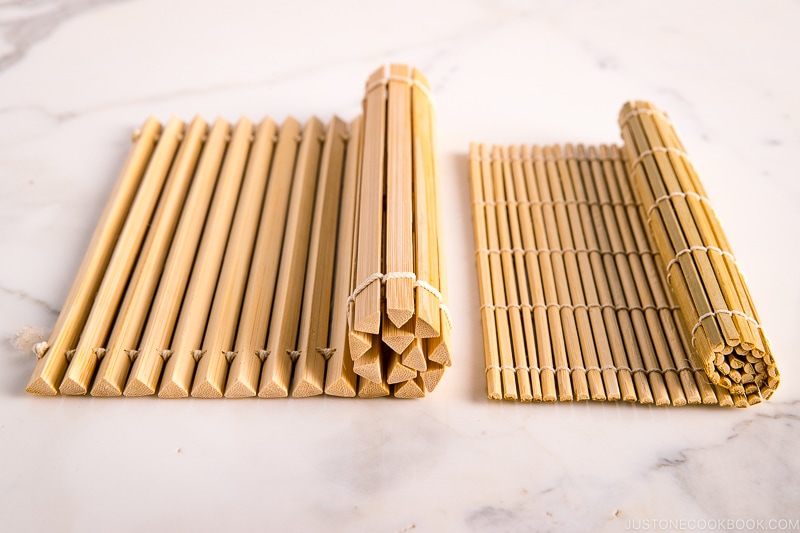
If you don’t have onisudare, you can still use a regular bamboo mat to give a similar effect to datemaki. The ridges are less striking but they still look pretty (see the right picture below).
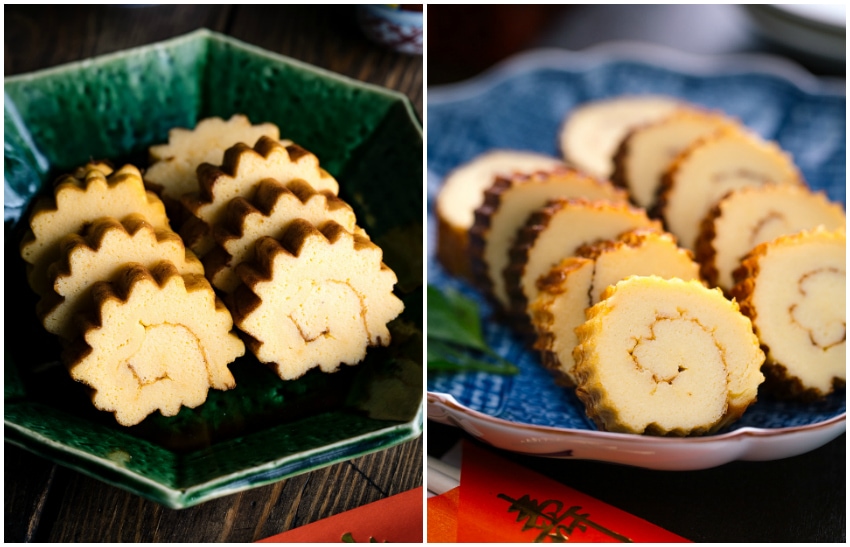
Quick Tips For Making Datemaki
- Strain the egg mixture through a fine sieve will yield a smooth, airy, and fluffy texture.
- The final texture of datemaki should be tender and moist in the middle and the top golden brown. Watch your oven toward the end of baking. If the top is not golden brown, switch to a broiler and broil for 2 minutes.
- Roll the omelette while it is still hot and gently score the omelet before you roll. This will help the omelette roll up easily without cracking.
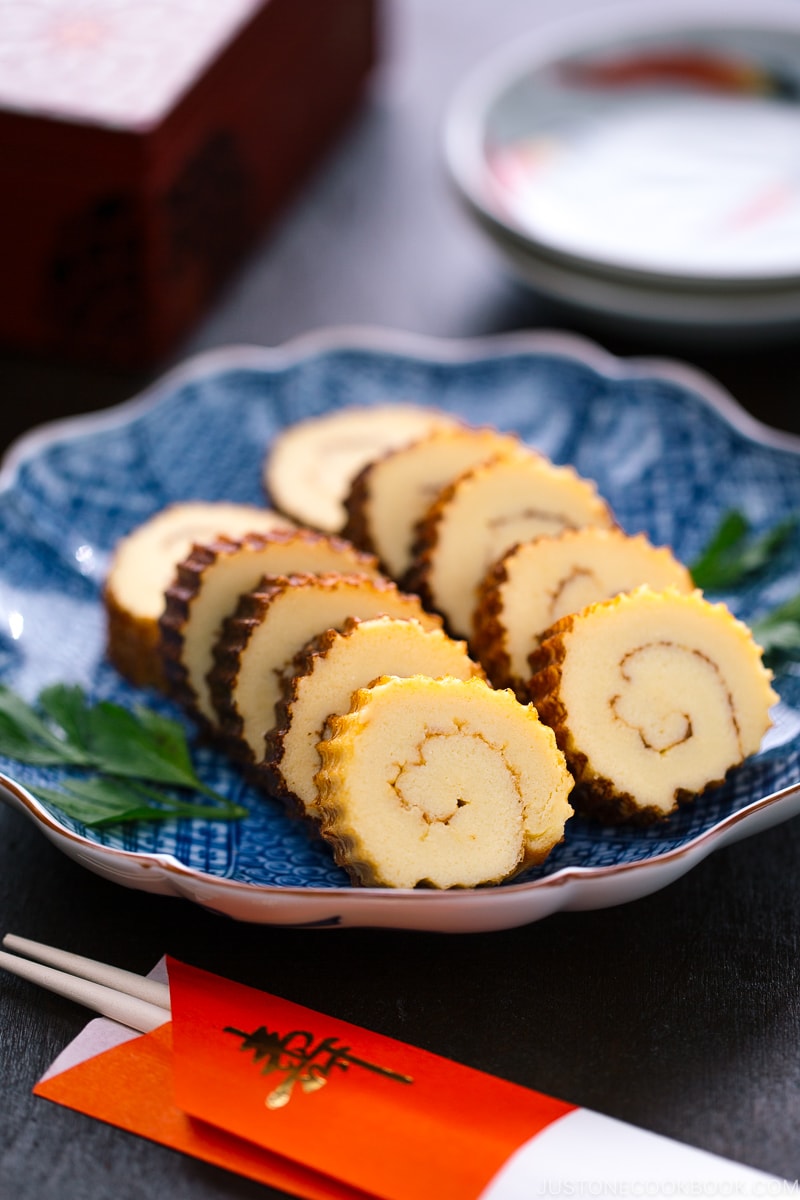
Perfect Make-Ahead Dish for Osechi
Datemaki is meant to be served at room temperature. Since it stores well in the refrigerator for 4-5 days, you can slice it and keep them in an airtight container or reusable plastic bag.
More Easy Japanese New Year Recipes
- Tazukuri (Sweet Soy Glazed Sardines)
- Instant Pot Kuromame (Black Soy Beans)
- Sekihan (Red Bean Rice)
- Namasu (Daikon & Carrot Salad)
- Yellowtail Teriyaki
- Butter Shoyu Scallops
- Inari Sushi
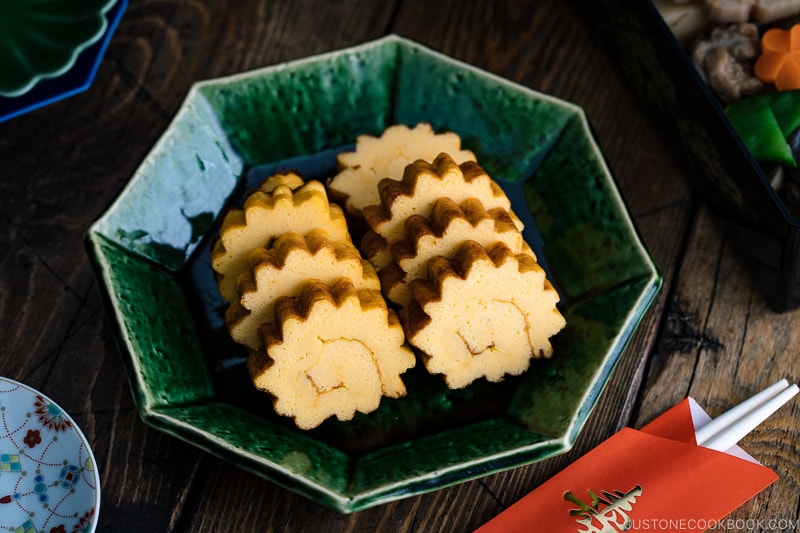
Wish to learn more about Japanese cooking? Sign up for our free newsletter to receive cooking tips & recipe updates! And stay in touch with me on Facebook, Pinterest, YouTube, and Instagram.
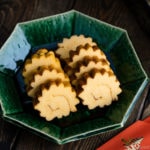
Datemaki (Sweet Rolled Omelette)
Video
Ingredients
- 1 package hanpen (fish cake) (110–130 g or 3.9–4.6 oz; found in the refrigerated or frozen section of a Japanese grocery; if you cannot find it, substitute puréed white fish (skinless/boneless), scallops, or shrimp)
- 4 large eggs (50 g each w/o shell)
Instructions
- Before You Start: If you will include this dish in your Osechi meal, I recommend cooking it 2 days before you plan to serve. For more helpful tips on planning your Japanese New Year feast, please read my A 5-Day Osechi Cooking Timeline blog post.
- Gather all the ingredients. You will need parchment paper and a bamboo sushi mat. In Japan, we use a special bamboo mat with thicker strips called onisudare, which makes big ridges or indentations on the Datemaki.
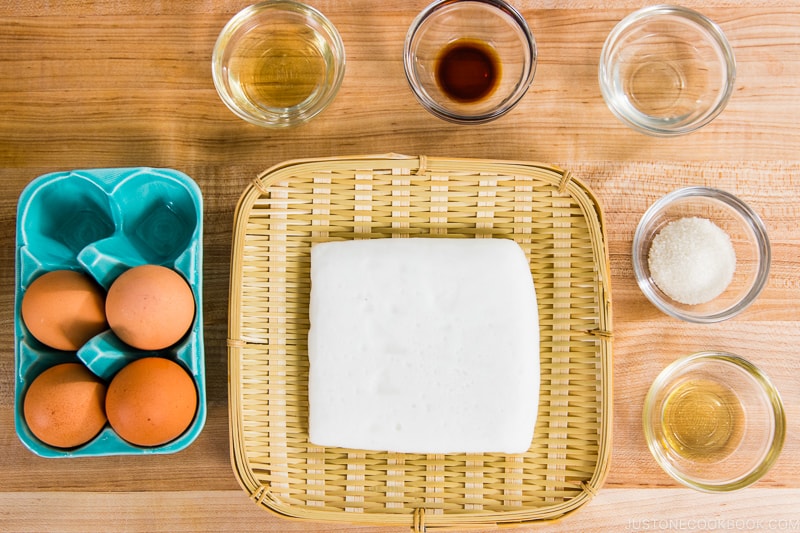
- Preheat the oven to 400ºF (200ºC). For a convection oven, reduce the cooking temperature by 25ºF (15ºC). Line an 8 x 8-inch (20 x 20-cm) baking dish with parchment paper.
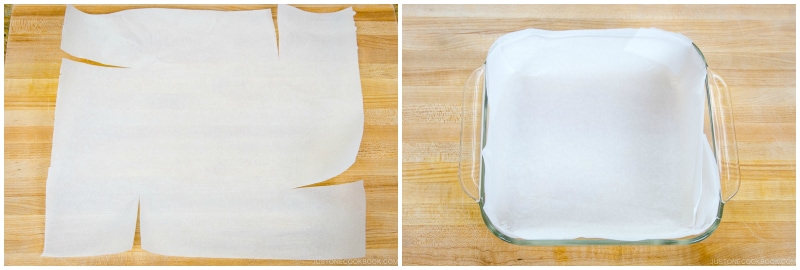
To Prepare the Ingredients
- Cut 1 package hanpen (fish cake) into ½-inch (1.3-cm) cubes. Next, whisk 4 large eggs (50 g each w/o shell) in a small bowl.
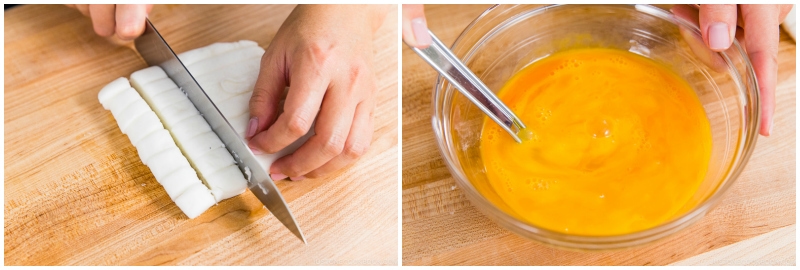
- To a blender or food processor, add the hanpen and all the seasonings: 2 Tbsp mirin, 1 Tbsp sake, 1 Tbsp sugar, 1 tsp honey, and ½ tsp soy sauce.
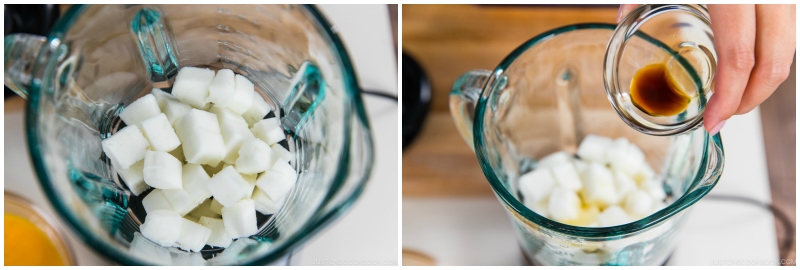
- Add the beaten egg and blend until smooth, about 1 to 1½ minutes.
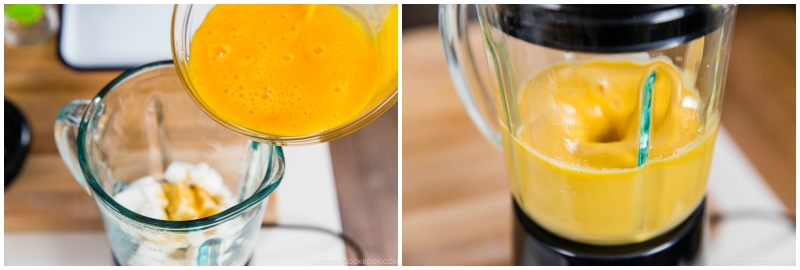
- Strain the egg mixture through a fine-mesh sieve into a clean bowl. You can use a spatula to help pass the mixture through the sieve.
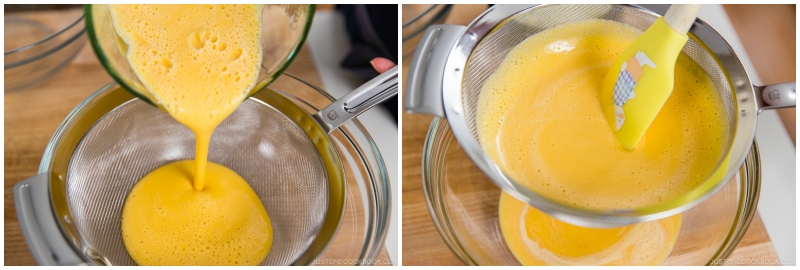
- Then, pour the mixture back into the blender jar and strain it one more time into the bowl. Finally, pour the strained mixture into the baking dish lined with parchment paper.
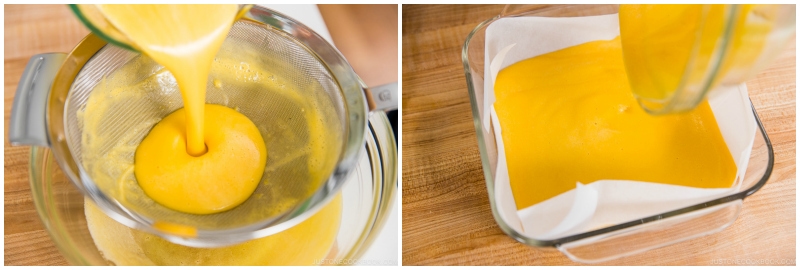
- Bake at 400ºF (200ºC) for 20 minutes or until slightly brown on top. If the top is not golden brown, switch to the Broiler setting and broil for 2 minutes or until the surface is golden brown. The center of the omelette will rise slightly as the top gets brown. It will shrink as it cools.
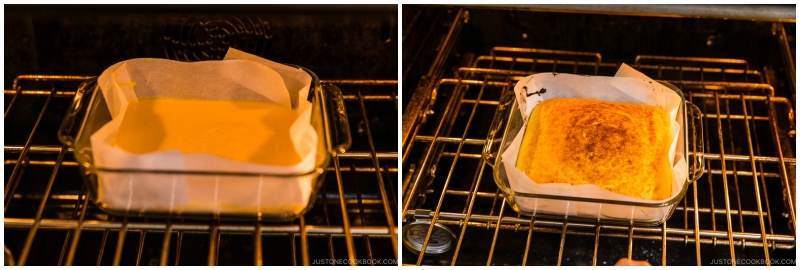
To Roll the Datemaki
- Remove the baking dish from the oven. Let the omelette deflate and rest until it's just cool enough to handle, only for 1–2 minutes (DO NOT LEAVE IT LONGER than that). We will need to roll the omelette while it’s still hot.
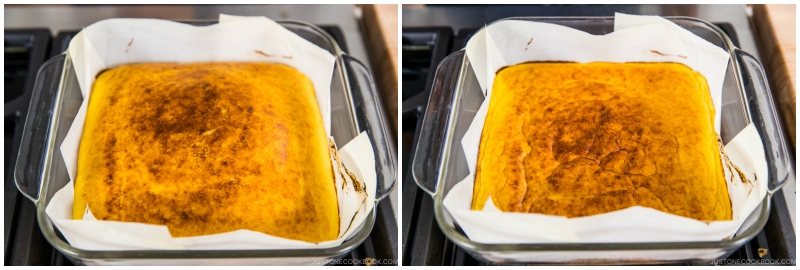
- Lift the omelette from the baking dish using the parchment paper and transfer it to a work surface. Then, place the bamboo mat over the omelette, with the flat side of the bamboo facing up.
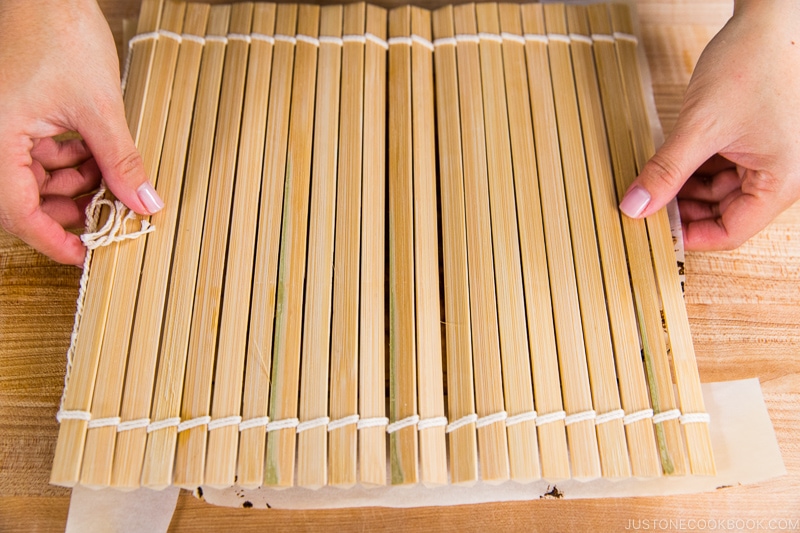
- Hold the omelette between the bamboo mat and the parchment paper. Then, carefully flip over the omelette onto the bamboo mat. Remove the parchment paper.
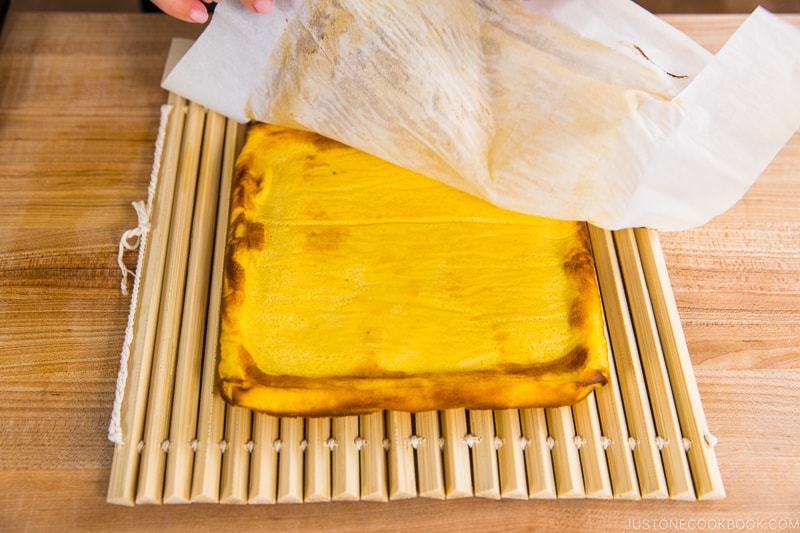
- Now, score the omelette: Rotate the bamboo mat so the slats line up with the direction of your knife. Starting at one edge, use a knife to carefully score along the length of the omelette about ⅛ inch (3 mm) deep. Make sure the knife is parallel to the slats of the bamboo mat. Repeat, scoring the omelette lengthwise every ½ inch (1.3 cm) until you reach the other edge. Tip: These incisions will help the omelette roll up without breaking or cracking.
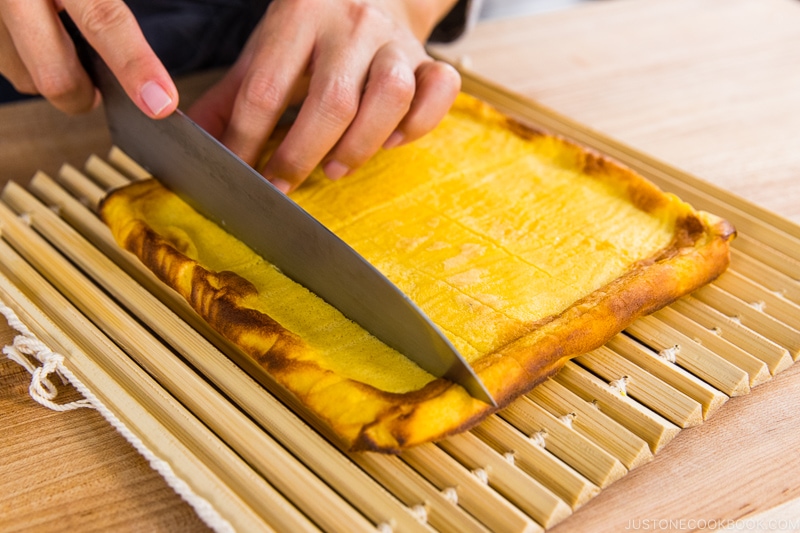
- Use the bamboo mat to roll the omelette into a tight cylinder. Then, continue to roll the bamboo mat tightly around the omelette to help hold its cylinder shape.
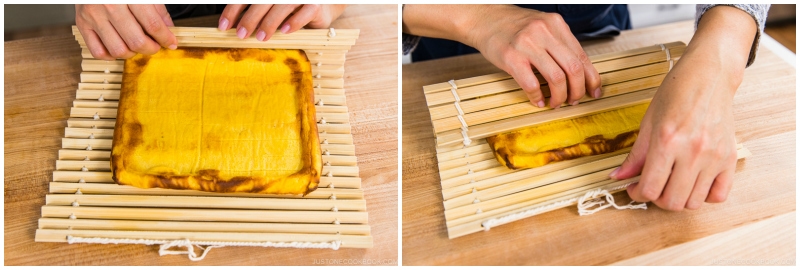
- Secure the bamboo and omelette roll with rubber bands so they hold the omelette cylinder firmly and tightly in place. Then, wrap it with plastic wrap. Let it cool completely for 2–3 hours.
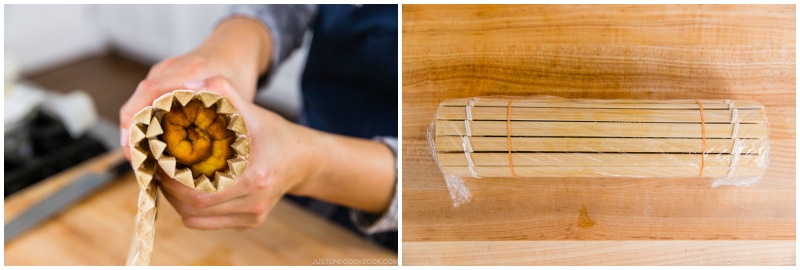
To Serve
- Once cooled, carefully remove the Datemaki from the bamboo mat. Cut crosswise into 12 equal slices about ¾ inch thick. Serve at room temperature.
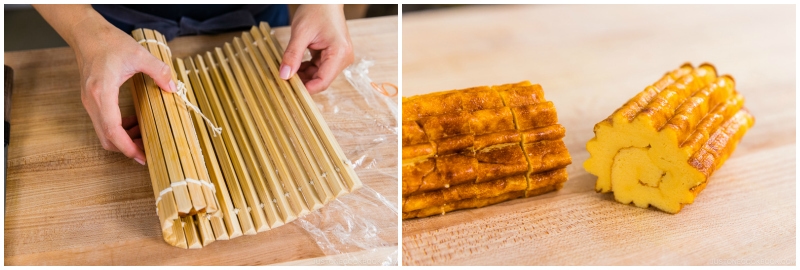
To Store
- You can keep the leftovers in an airtight container and store it in the refrigerator for 4–5 days.
Nutrition
Editor’s Note: This post was originally published on Dec 26, 2013. The pictures have been updated in December 2019. The post has been republished on December 2023.
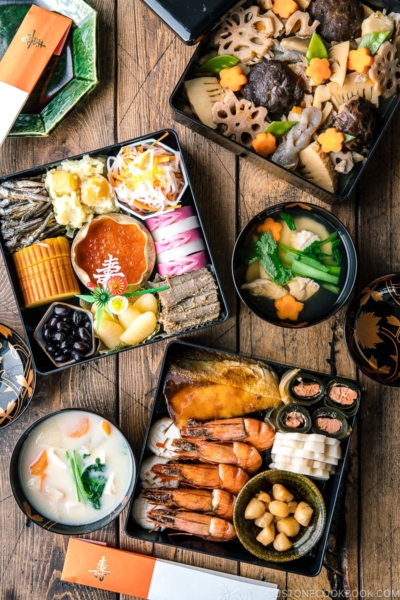
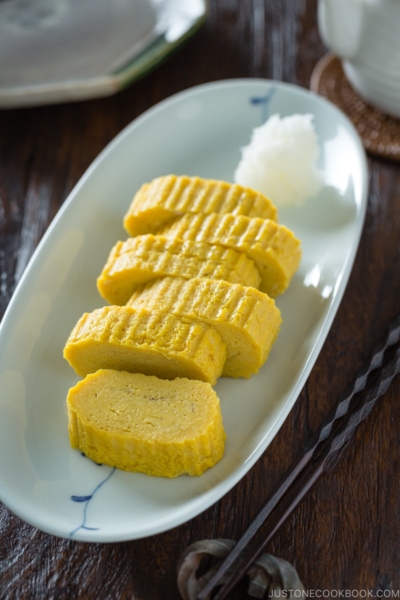
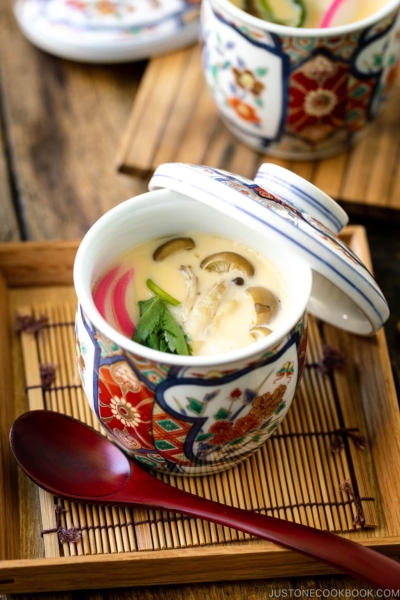
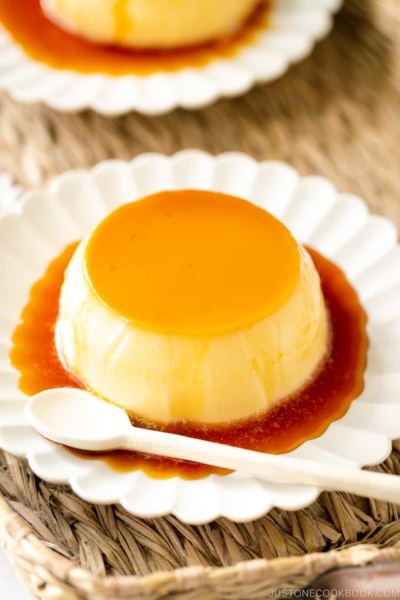





Hi Nami,
I substituted Hanpen with scallops (same weight) and used maple syrup instead of honey, but it came out a little dry, with not much taste as with Hanpen. It also wasn’t as sweet as the original. Any suggestion to turn out more like the original? I wanted to avoid Hanpen because it seemed highly processed and also honey due to toxic effects when heated. This dish is a very beautiful and traditional and would like to perfect it.
Thank you,
Ted K
Hi Ted, Thank you for testing Nami’s recipe!
Hanpen is made from white fish, such as Alaska Pollock or cod, along with salt and kombu dashi, which is combined with grated Japanese mountain yams. To achieve a similar texture, we suggest adding a small amount of Nagaimo to a blender. We hope this helps! 🤗
https://www.justonecookbook.com/hanpen-fish-cake/
Is Hanpen the same as fish cake sheets? I hope so cause tomarrow is New Years and this is my first time doing this dish
Hello, Tina. Thank you for trying Nami’s recipe. 🤗
Yes. It is a type of fishcake. Here’s additional information on Hanpen.
https://www.justonecookbook.com/hanpen-fish-cake/
I would really love to make this, I was wondering if you were planning to carry the onisudare in the JOC goods store someday? It’s very hard to find one, and I would love to have a more traditional look when I prepare osechi for my friends
Hello Fred! Thank you for reading Nami’s post and for your request! I will add it to the wish list!
Aloha Nami,
I found that heating honey from baking could have some adverse or toxic results. Can you think of any substitute for honey? How does honey help in this recipe? Thank you for being so helpful and I appreciate all the wonderful recipes I have tried on your website.
Ted Kanamori
Hello, Ted. Thank you for trying Nami’s recipe.
Honey adds moisture and helps the food brown faster. You can substitute it with sugar in this recipe if you prefer.
We hope this helps!
Thank you
You are welcome, Ted!
I’m using many of your recipes to prepare dishes for osechi-ryori, however, I’m having a hard time finding hanpen in Hawaii, even at Asian markets. Would kamaboko or other fish cake make a suitable substitute? If not, we can try raw surimi sold in Chinese fish markets.
Thank you!!
Hello, Dean. Aww. 🥰 Thank you so much for making Osechi with Nami’s recipes!
We have never tried this recipe with substitute ingredients, but cod fish, shrimp, tofu, or white bread are commonly used.
We hope this was helpful!
Thank you!
Hello,
I cannot find Hanpen. Can you tell me what you suggest as substitute and the amount? Have you ever used a substitute for hanpen and still really liked the results? Thank you!
Hi LF! The flavor will be different, but you can use silken tofu as a substitute. Please make sure to drain the water from tofu first by placing the paper towel over tofu, pressing with a plate, etc.
You can also try white bread with milk. (moisten the bread with milk.)
We hope this helps!
Where can you find the Onisudare mat in California?
Hi Ann, We found it! https://mtckitchen.com/datemaki-omelet-bamboo-makisu-11-8-x-11-8/
Namiko, I want to try making your Datemaki recipe, but cannot find Hanpen anywhere. I found salted Surimi and Yamaimo. Do you have a recipe for Hanpen?
Thank you!
Hi Kaila,
Sorry…We currently don’t have the recipe on the site. We’ll make sure to add the recipe to Nami’s list. Thanks for your request!
I made this for our New Year’s Day party and it came out wonderfully! Some of our guests commented that the flavors gave them fond memories of their recent trip to Japan and the wonderful egg dishes they had there. Thank you for the easy to follow recipe! I’m ready to tackle more for next year’s event!
Hi Jeff! Wonderful! I’m so happy to hear yours came out well and the guests enjoyed this recipe! Thank you for your kind feedback! 🙂
How early can one make this before planning to serve?
Hi Melissa! You can make it 2-3 days ahead of time. 🙂
Do you think datemaki would be appropriate as an ingredient in futomaki, inlieu of the tamagoyaki. Maybe cooked in a larger baking sheet to be slightly thinner and of course sliced into strips instead of rolled.
Hi Grace! Sure! I’d love that idea. 🙂
I just made datemaki using this recipe for part of my osechiryouri and the first batch turned out great! The only thing I realized I need to be more careful with next time is to not make the slits of the datemaki too deep right before rolling it (#8 of instructions). I did that with the second batch and it was a challenge to roll it without pieces falling off! It was a success for a first time recipe and I will make it again next year, thanks!
Hi Kay! Thank you for trying this recipe! Yeah, shallow slits will be enough to be a bit more flexible, so don’t try to make perfect slits, better than accidentally cutting off. xD Thank you for your kind feedback! ox